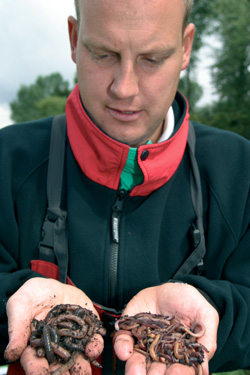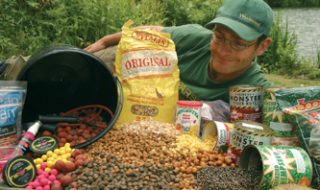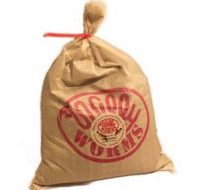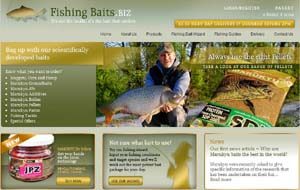Paul Boothby of Maver, on fishing chopped worm on canals
WORMS are the most natural of all baits and the beauty of fishing them on canals is that if there are any bonus fish in the area, they often find it hard to resist a well-presented wriggler. If you know a stretch of canal where there are bigger fish like skimmers, bream, chub, perch and even carp then chopped worms could be the key to unlocking the water’s true potential. However, it’s not just a case of feeding and waiting, there are all sorts of other tricks you can play to make the most of this awesome bonus fish bait…
When The Time’s Right
Chopped worms are the daddies of all baits for targeting bonus fish on natural waters and knowing when to use them is the key to success. If there are any bonus fish in the stretch, by putting in chopped worms you’re likely to catch the odd one on them if you also fish a couple of squatt lines. But what about making your bonus line into a match-winning line.
Well, on canals that have a lot of far bankside cover, like the Shropshire Union Canal here at Pendeford, you can make your bonus lines your only swims and walk the matches simply because there are enough big fish in here to beat someone who targets the squatt fish.
The same goes for many canals that contain bankside cover and you can usually be sure that where you find an overhanging tree you’ll find bonus fish. A bold, chopped worms and casters approach will usually pay off.
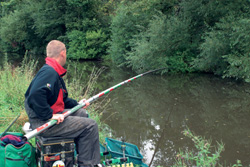 |
| Far bank covers spells bonus fish. |
What Worms?
I like to carry a variety of differently sized worms to cover my options but, because I’m targeting bonus fish, I like to use relatively large worms and dendrabaena are my number one choice. I usually bring along half a kilo of medium or mixed size dendras but I wouldn’t expect to use that amount unless I’m catching really well. Usually around a quarter of a kilo is enough. I also like to bring a few lobworms with me simply because they’re useful for holding better-stamp fish in the peg. They’re also useful for holding smaller perch in the peg because you can cut a lobworm into two pieces and introduce them to the peg. As the particles are so large the smaller fish can’t eat them – they just succeed in attracting bigger fish by causing disturbance in the swim, which is exactly what you want.
Getting The Chop
So, once you’ve decided you’re going to fish worms, what about chopping them? How finely you chop your worms depends on the quantity of fish you’re looking to catch and the size of fish expected. There’s much more to it than throwing a handful of worms into a tub and chopping them a bit. I usually like to introduce differently sized pieces of worm to the swim to help attract both big and small fish to it. I always chop some of my worms very finely to help kick-start the peg. I also add some larger particles into the feed to give the fish something to look for and I then use one of those pieces on the hook. The size you choose to chop your worms also depends on the flow of the venue’s water. The quicker it’s moving the larger the pieces of worm you need to use, otherwise they’ll be washed downstream.
Additional Baits
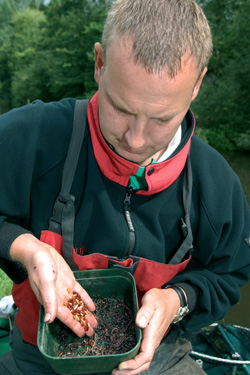 |
| Casters and worms go together like strawberries and cream! |
Because worms are very rich in oils you need to introduce other baits with the segments to help hold the fish and there’s no better complement feed than casters. Casters and worms go together like strawberries and cream, only they’re not quite as tasty in my opinion. I always like to crush some of my casters in with the worms when I’m feeding with a pole pot because the juices disperse into the water to help attract fish. However, it’s important to feed some whole casters as well to hold better fish in the peg and give them something to pick out of the feed.
Also, if you’re using a lot of worm feed, it can become quite expensive – so casters just help to keep the cost down.
Feeding
Your feeding is a big part of what catches you fish, get it wrong from the off and you could ruin your peg before you’ve even put your rig in.
To begin a session I always like to start on the cautious side and today I’m feeding three areas of my swim to cover my options and all the feed is introduced to a feature of some kind. I like to spread the lines out and the first two are fished across to the far-bank features at 11 metres in a 10 o’clock and 2 o’clock position. The third line is fished at 16 metres down the swim to the left. I have introduced half of a large pot full of worms and casters to each swim and I’ve included crushed casters in the feed.
I’m then going to loose feed casters over the top of each swim to help attract and hold more fish in the peg. I know that many anglers like to feed canals from a small pot on the pole tip – but I believe that by loose feeding you spread the fish over a wider area and you can therefore hold more fish in your peg. A catapult also allows you to feed far more regularly than you would with a pot and it also means you don’t have to ship in and out as regularly, keeping your hook bait in the water for longer. I will only top up with worms again once the peg tails off completely, which usually happens after you catch a bigger fish like a chub or bream.
Hook Baits
Obviously, worms are the number one hook bait over worm feed but there are certain parts of the worms that are better. I particularly like to use the tail of a worm simply because it kicks a lot more than any other part and that’s exactly what you want to present over a worm and caster feed. It’s very important to work the hook bait by lifting and dropping it to help induce extra bites and you must hook the bleeding end of the worm. The head of the worm can also be good sometimes, although you wouldn’t think it could make a lot of difference which part is used – trust me, it does.
Also, you can use caster hook baits either singly or as doubles. A worms and caster cocktail can also be successful; or two smaller pieces of a worm can be an awesome change bait, particularly for bream.
The way you hook the bait is again very important and I hook a piece of worm like a deeply-hooked maggot, leaving the hook point exposed to allow me to hit most bites.
The Rig
When you approach your swim and intend to feed only worms and casters for bonus fish, obviously the first thing you need to look for is vegetation and cover over or in the water. The peg I’m on today has got everything in it to hold better fish, so I’m going to exploit those features. However, you must find enough depth to fish in and I believe that anywhere from two feet to three feet is the ideal depth. That way, bigger fish can come into the peg and they have enough water to comfortably feed in and also, with that little bit more depth, it’s less likely the pole will spook them.
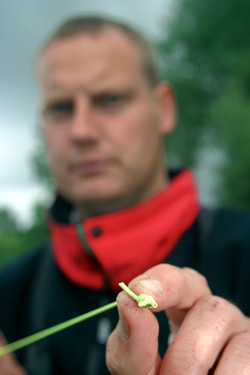 |
| He uses the octopus style of rig connection. |
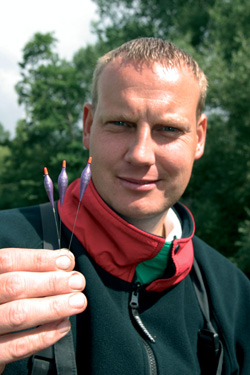 |
| Paul prefers a dibber style float for far bank work. |
Float choice is a very personal thing but for this style of fishing I think a bristled, dibber-type pattern is perfect. My favourite pattern is the Maver Track XL design which has a wire stem and relatively slim body with a buoyant balsa tip. Bristled patterns are generally dragged under with a bigger hook bait and proper-domed, dibber-shaped floats are just too buoyant. These Maver XL track floats can be dotted down to a dimple if you need and that will help you spot shy bites on harder days.
My rig today consists of an 0.3g Track XL float that’s shotted with a few No11s spread out in the lower two-thirds of the rig. Main line is 0.14mm Maver Genesis to a 0.10mm hooklength of the same material. The hook is a size 16 Gamakatsu 1310B that has a round bend and features a micro barb to help hold the hook bait on.
The rig also features a No10 back shot to help stabilise it in the water and to keep the small amount of line from the pole tip to the float out of the wind.
Paul Boothby’s Top 10 Tips For Worms
Always use fresh bait. Freshly turned casters and worms that have been kept cool are far better fish attractors than older bait.
Always work your bait by lifting and dropping the rig. You can also try dragging the worms about the swim to induce bites.
Always chop some of the worm feed very finely to create a lot of attractors in the water around it.
When the water really cools down feed some chopped lobworms to hold better fish in the peg.
Use a round-bend hook that holds the worm on well. You need to leave plenty of hook point showing to hit fast bites.
Loose feed casters over the top of the main feed to help attract and hold more fish in the swim.
Use a worm’s tail when you want a very active bait but never ignore the head section.
Because you’re looking to target better fish with worms don’t scale your tackle down too much.
Find a decent depth to fish in. A depth of two to three feet is perfect as you’ll be able to hold better fish there.
Make sure you choose the right size worms for the species you’re targeting. You can’t go far wrong with dendrabaena worms most of the time.
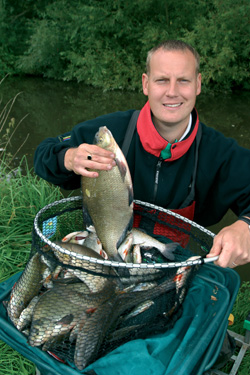 |
| A great bag of Shropshire Union Canal fish on the deadly dendra! |
Types of worm
The four main types of worms used in the UK for fishing are dendrabaena, redworms, lobworms and brandlings, which are now not as popular as they used to be. These four types of worms, contrary to popular belief, are all native to the UK. Lobworms are the most natural of all as they’re found near rivers and are usually washed into the water off nearby land when there’s a heavy rainfall.
Redworms are actually the softest of all worms available, which is probably what makes them so appealing to skimmers and bream in particular. Dendrabaena worms are the toughest of all because in places where they are native to the UK, they live under leaves in large forest areas, so have to be able to cope with rapid changes in temperature.
The yellow fluid a worm sometimes excretes from the head is actually caused by the worm being stressed and fish don’t like it at all. To avoid your worms becoming stressed, they need to be fed properly with cold, cooked mashed potato, brown crumb and peat, all mixed together into a paste-type consistency. Also, worms have to be stored at a constant temperature and the best is 2°C. The matter they’re stored in needs to have a pH level of 6.5.
Worms also like citrus fruit and banana is another good feed. You’ll know when what you’re feeding them is wrong because they’ll actually develop red skins, which is actually burnt from the food.
It takes a worm 16 weeks to grow from half an inch to a few inches providing it’s kept at the correct temperature and has a good food supply.
Dendrabaena worms are the most popular in the country simply because they’re tough. They can withstand being shipped long distances and they’re in good supply – fish love them. However, many top worm anglers believe lobs are the top bait as they’re the most natural of all, if a bit more expensive.
Many anglers also try to breed their own worms. However, they simply will not reproduce in a confined area as they lay the worm eggs, then leave the area so that there’s enough food left for the baby worm hatch.
Often, you’ll also find worms will huddle up in one spot in a container and that’s where they’re happiest, where there’s enough food and where the temperature is right for them.
A dendrabaena worm, unchopped, will last in water for around 14 hours and because all their organs are within the top third of their body, you can actually chop the tail off and it’ll re-grow a new part, albeit stunted.


